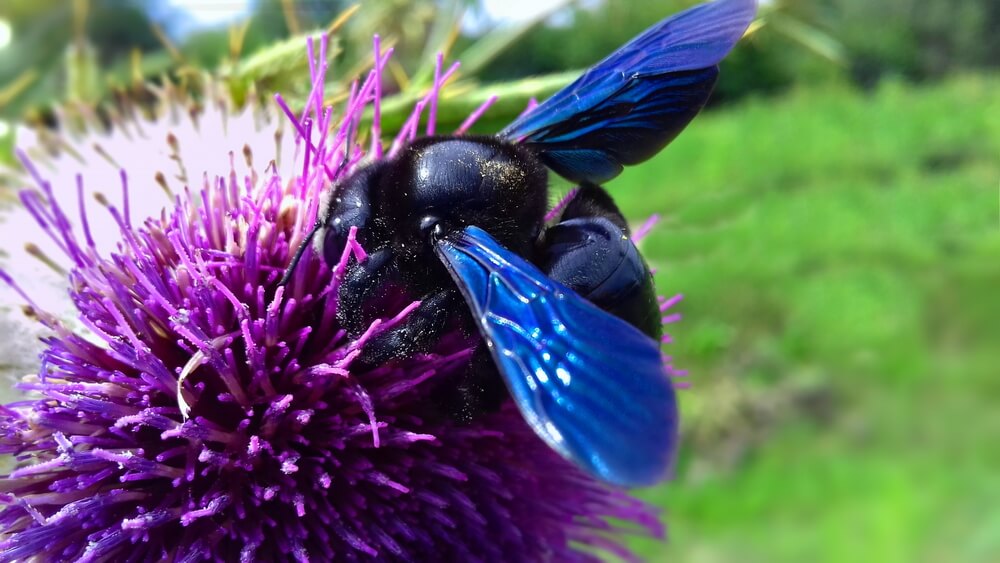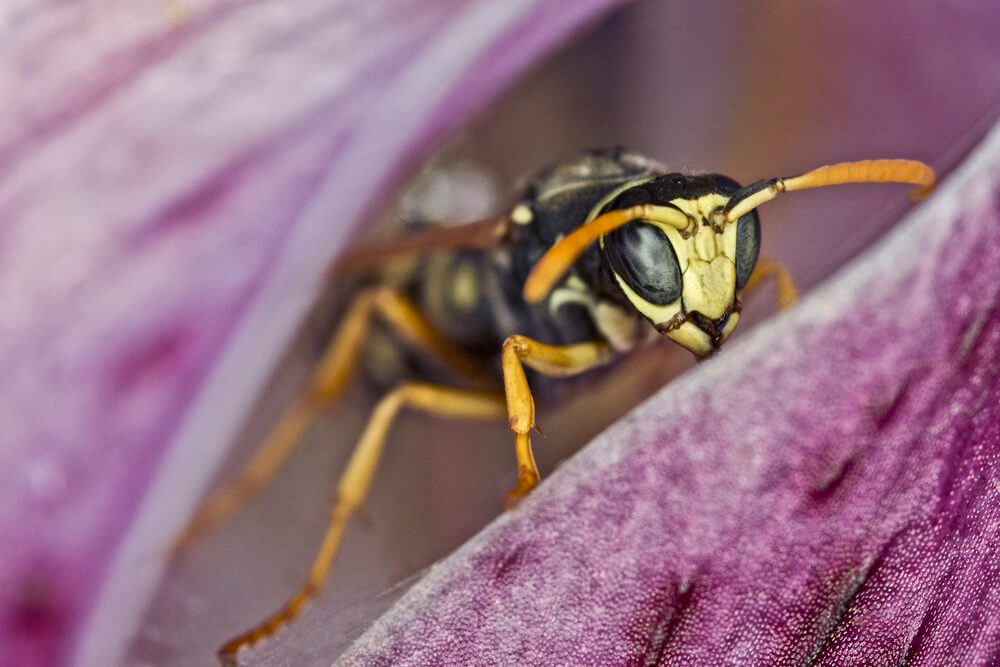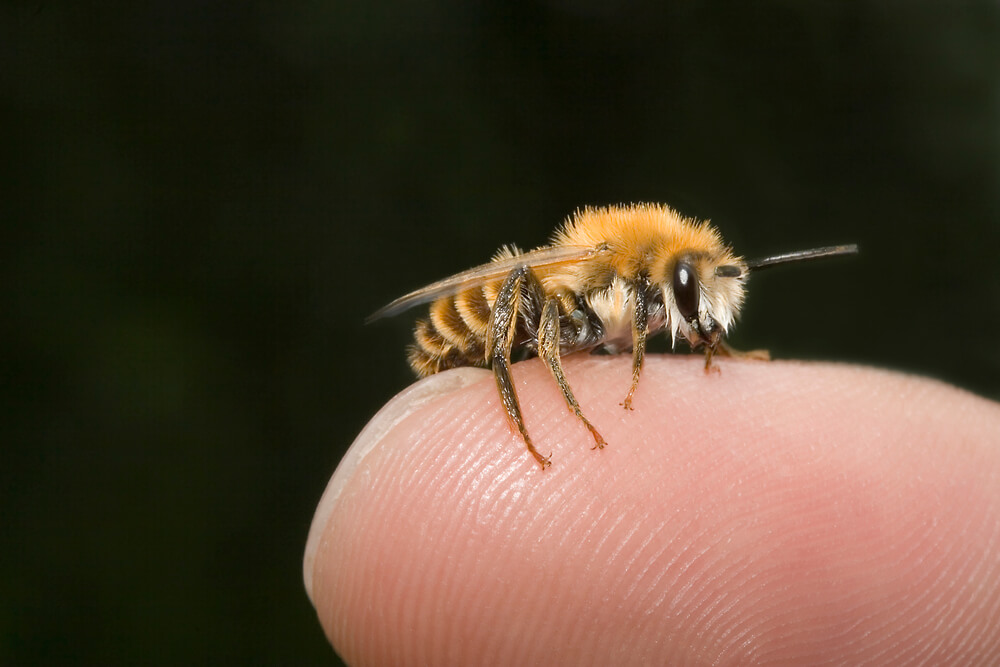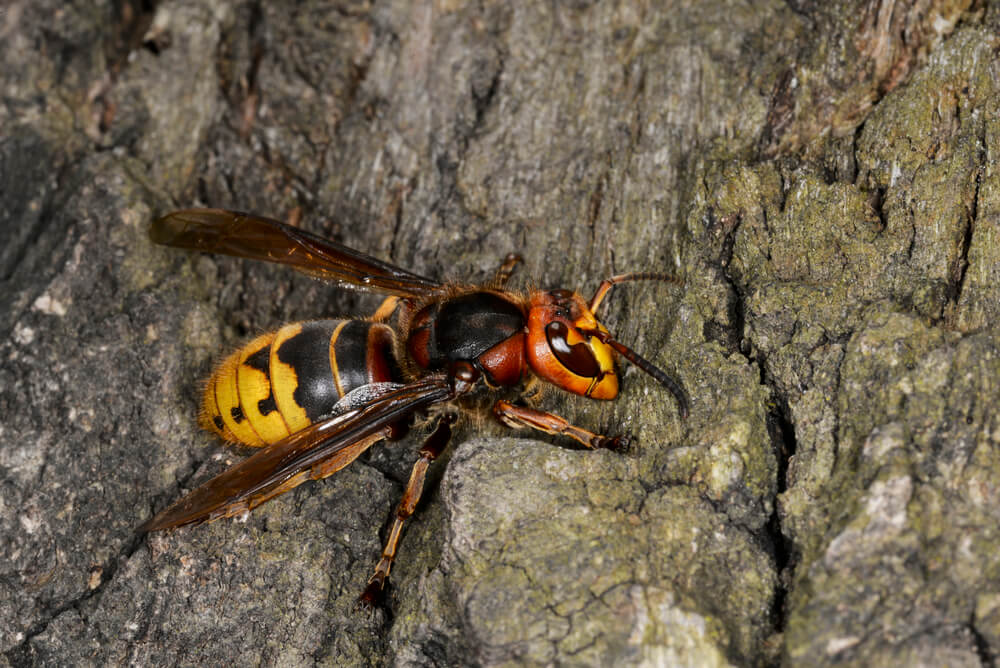Can Bees Be a Different Color?
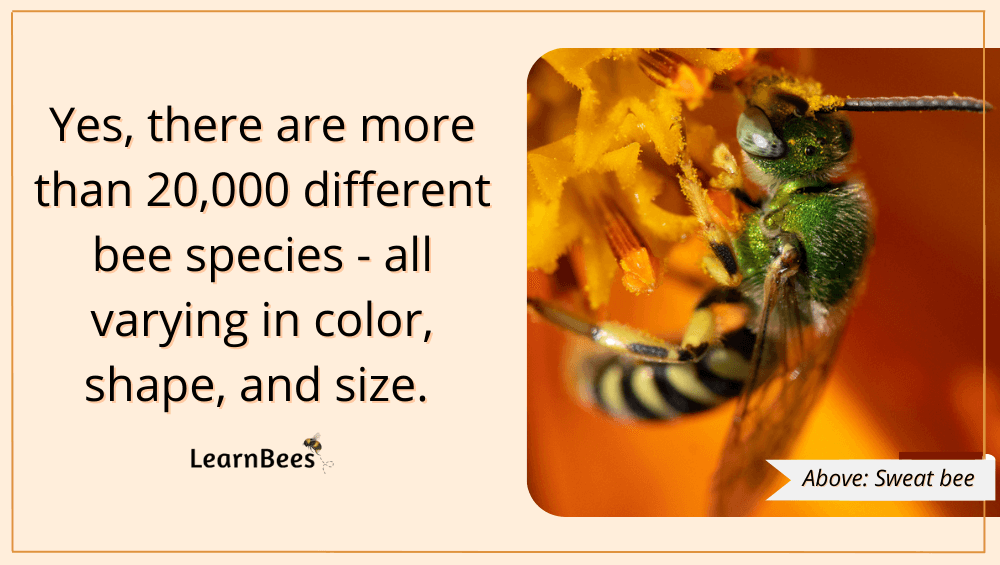
Bees come in colors ranging from:
- Black
- Brown
- Gray
- Yellow
- Orange
- Red
- Blue
- Green
That said, most people think of yellow or black colors when they think of bees. Honeybees and bumblebees are two common examples of this.
But keep in mind:
There are more than 20,000 bee species around the globe.
Meaning, each bee species has unique physical characteristics that set it apart. Some bees are small and brightly colored, while others are big and dark-colored.
For example:
Sweat bees (Augochlora pura) are metallic green bees native to the eastern United States. They’re small, gentle bees that don’t live inside social colonies like bumblebees. Instead, sweat bees live alone.
But what other types of colored bees are there?
Let’s find out.
Blue Colored Bees
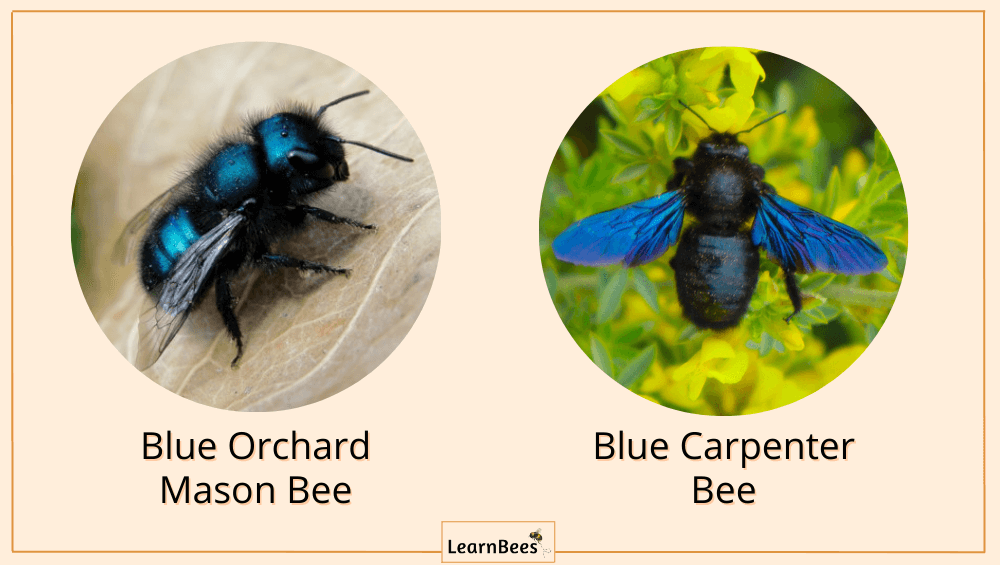
Several species of blue-colored bees exist all over the world. Their blue coloring is especially noticeable when the sunlight hits them.
Here are a few examples of blue bees:
Blue Orchard Mason Bees (Osmia lignaria) are a deep metallic blue with small amounts of fuzz. They’re avid pollinators of fruit crops such as apples, pears, plums, peaches, and blueberries. They’re also solitary bees that live alone – not inside social colonies with other mason bees.
Blue Carpenter Bees (Xylocopa caerulea) are large bees with a hairy blue thorax. They’re native to Southeast Asia, India, and China. As their name suggests, carpenter bees are known for building nests into wood. The female carpenter bees use their strong mandibles (jaw) to make perfectly round nesting holes.
Blue Banded Bees (Amegilla cingulata) are native to Australia and have beautiful blue-striped abdomens. They’re buzz pollinators, which means they vibrate their wings to shake the pollen out of flowers.
Green Colored Bees
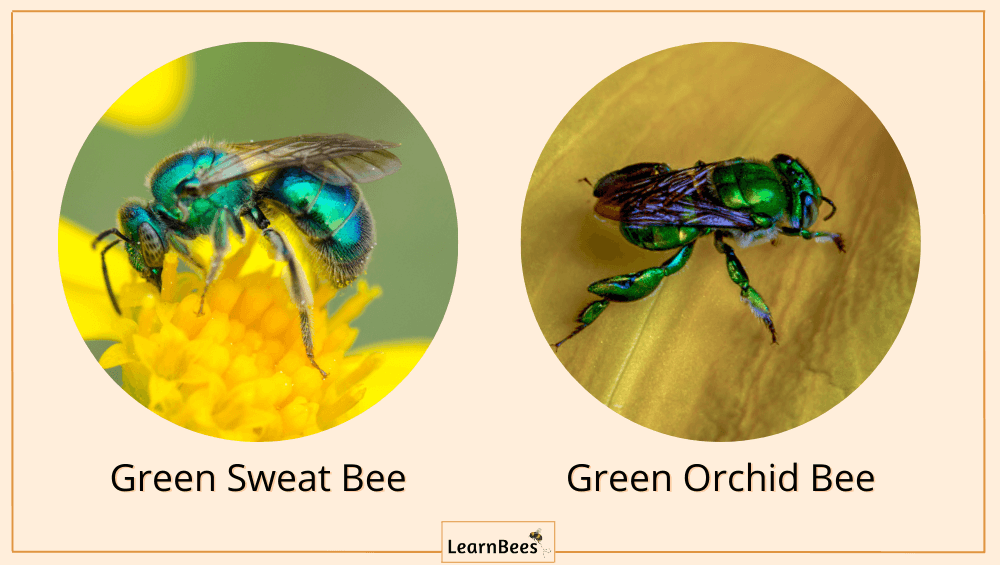
Green-colored bees are common in the southern United States. But many of them are so small that they go unnoticed.
Here are a few examples of green bees:
Green Sweat Bees (Halictidae) are beautiful metallic green bees that only measure about 1/4 inch long. One of the most apparent traits of sweat bees is their attraction to sweat. Sweat from humans offers them precious moisture and salts needed for their diet.
Green Orchid Bees (Euglossa dilemma) are about the size of honeybees, but they’re easily distinguishable with their green coloring. They’re gentle-natured bees that are unlikely to sting. Interestingly enough, some species of orchid bees have tongues that are twice as long as their bodies.
Green Carpenter Bees (Xylocopa aerata) are the largest native bees in Australia. Their eye-catching coloring and loud buzzing easily grab attention wherever they fly. They’re typically considered solitary bees – although sometimes mothers will share nests with their daughters.
Red Colored Bees
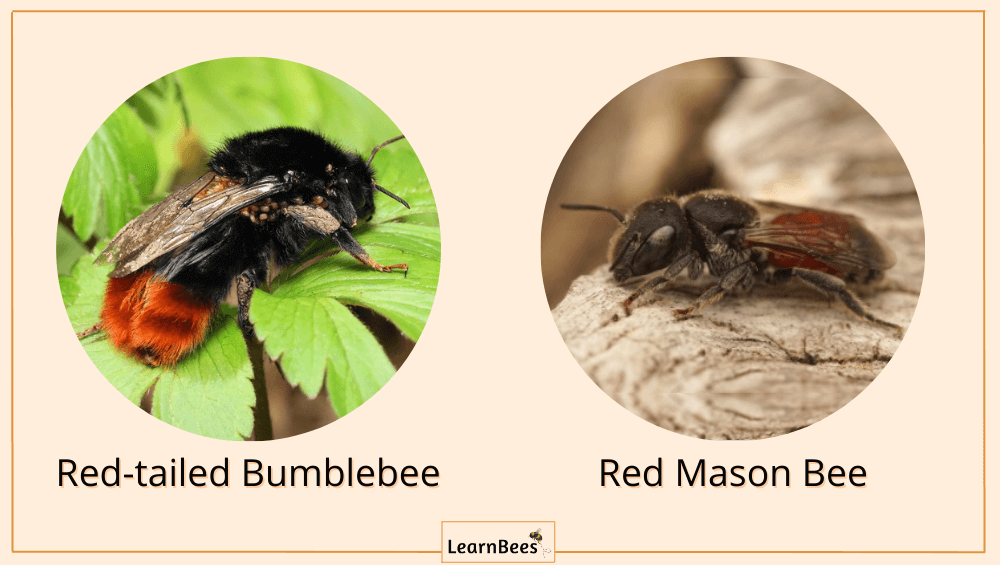
Truly red bees are uncommon, however, there are a few species of bees that have deep red coloring. The red color is more apparent in the sunlight.
Here are a few examples of red bees:
Red Mason Bees (Osmia rufa) are small but mighty bees with a bronze-reddish color on their thoraxes. The males are smaller than the females and have a white spot on their face. Newly hatched mason bees will hibernate over the winter and come out in spring.
Red Dwarf Honeybees (Apis florea) are the most commonly found honeybees in tropical Asia. They get their name thanks to their smaller size – only measuring 7–10mm. Dwarf honeybees haven’t been used for honey production since they produce very little honey compared to eastern honeybees.
Red-tailed Bumblebees (Bombus lapidarius) are mostly black with red tails. They can be found throughout Central Europe. The males also have yellow facial hair as well as red tails, making the males and the females easily distinguishable.
Orange Colored Bees
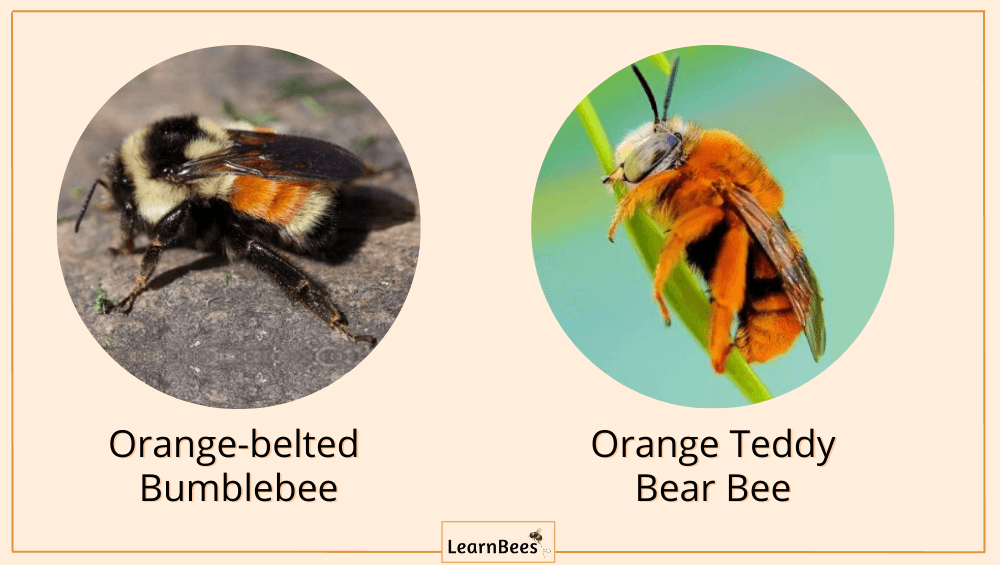
There are many different types of bees with orange coloring. These bees are usually a mixture of orange, yellow, and black.
Here are a few examples of orange bees:
Orange Belted Bumblebees (Bombus ternarius) are common throughout Canada and the United States. They’re tri-colored bees that are orange, yellow, and black. Their prominent orange ‘belt’ is where they get their name. Like other bumblebee species, the orange-belted bumblebees live in social colonies with a queen, worker bees, and drone bees.
Teddy Bear Bees (Amegilla bombiformis) are Australian native bees known for their distinct orange coloring. They also have green eyes that give them a unique look compared to many other types of bees. Despite popular belief, teddy bear bees aren’t bumblebees. They’re actually carpenter bees.
Orange Orchid Bees (Euglossa hansoni) are often mistaken for flies due to their small size and coloring. However, they’re a diverse kind of bee commonly found in North and South America. With that in mind, not all orchid bees are colorful – some are brown or black.
White Colored Bees

White bees are typically a mixture of white, black, or brown. With that in mind, white bees aren’t albino bees. Instead, they usually have white stripes or white tufts of fuzz covering their bodies.
Here are a few examples of white bees:
White Leafcutter Bees (Megachile rotundata) is a solitary bee species initially from Europe but has been introduced worldwide. Farmers love white leafcutter bees because they’re avid pollinators of alfalfa, carrots, many vegetables, and some fruits.
White Digger Bees (Amegilla quadrifasciata) are most commonly found in Europe, Central Asia, and North Africa. They’re known as “digger” bees because they dig their nests in soils. The females store pollen and nectar to feed the baby bees.
White-banded Bees (Lasioglossum Halictinae) have white, furry bands on their thoraxes, while the rest of their bodies are brown or black. They’re part of the sweat bee genus, which includes more than 1,700 species.
FAQs on Bees Color
- Are bees black and yellow or yellow and black?
- How many colored bees are there?
- What colors do bees like?
- Do blue bees exist?
- Are purple bees real?
- Do green bees exist?
- What color are most bees?
- Are bees actually yellow?
- Can bees be just black?
- Is there a rainbow bee?
- Can bees change color?
- Is a blue bumblebee real?
Are bees black and yellow or yellow and black?
Either way you say it is okay because it means the same thing. Many types of bees are both black and yellow, with notable examples including the Eastern honeybee and American bumblebee.
—> Go back to the FAQs on bees color
More to Explore:
How many colored bees are there?
The most recognized bee color is black and yellow, but there are many more different colored bees. For example, there are blue, orange, red, green, and even white bees.
This color variation isn’t surprising once you realize over 20,000 different bee species exist. In fact, many bees native to the United States are either blue or green – not yellow or black.
Of course, there are still similarities among the various species, including wings, stingers, hair, etc. But different bee species also have unique characteristics such as nesting habits, honey production, and mating processes.
—> Go back to the FAQs on bees color
More to Explore:
What colors do bees like?
Some research suggests that bees are drawn to purple, blue, and violet flowers. However, this doesn’t mean that bees only pollinate those types of flowers. Bees are the most drawn to flowers with rich pollen and nectar sources.
For example, veronica, salvia, and zinnia plants are common bee-attracting flowers. If you plant these in your yard, then your garden will become a pollinator magnet.
So, in a nutshell, bees are more drawn to pollen and nectar than anything else. This makes sense, considering bees rely on pollen and nectar as their primary food source. Pollen provides them with protein, while nectar gives them the carbohydrates they need for energy.
—> Go back to the FAQs on bees color
More to Explore:
Do blue bees exist?
Yes, blue bees do exist. One type of blue bee is the Osmia lignaria or blue orchard bee. This species is native to North America.
The blue orchard bee is a solitary bee, meaning it doesn’t live in social groups like honeybees. Instead, each female bee creates and cares for her own nest.
Honeybees are essential for commercial agriculture, but native bees like blue orchard bees are better pollinators of native crops. There are 140 species of orchard bees in North America. Orchard bees are known for visiting fruit trees. This includes apple, plum, pear, almond, and peach trees.
The blue orchard bee, Osmia lignaria, is sought-after for its quickness in pollinating fruit trees. In fact, it’s one of the only managed native pollinators in agriculture.
—> Go back to the FAQs on bees color
More to Explore:
Are purple bees real?
Yes, there are bee species that are known for their purple coloring.
For instance, Xylocopa violacea, the violet carpenter bee, is a large bee found in Europe and Asia. Like most members of the carpenter bee species, it builds its nest in wood. But at first glance, you might think the violet carpenter bee is black. However, you’ll notice tones of blue and purple once you see them under sunlight.
—> Go back to the FAQs on bees color
More to Explore:
- Ground Bees: Are They a Threat to Your Yard?
- Wasps vs. Honeybees: Are They Different?
- Do Bumble Bees Bite?
Do green bees exist?
Yes, there are green bee species. One example is the Agapostemon texanus or Texas green sweat bee. As its name suggests, this species is found in the state of Texas in the United States.
The Texas green sweat bee gets its name because it often lands on people to drink their sweat. While this might sound gross, sweat is a good salt source for bees.
In terms of appearance, the Texas green sweat bee is primarily black. But it also has green markings on its abdomen, which is the part of the bee’s body right behind the thorax.
The Texas green sweat bee is solitary, meaning it doesn’t live in hives like honeybees. Each female bee creates and cares for her own nest.
—> Go back to the FAQs on bees color
More to Explore:
What color are most bees?
Bees come in many shapes and colors. After all, there are over 20,000 different species found worldwide. With that said, most bee species tend to have at least some brown or black markings on them – in addition to other colors.
—> Go back to the FAQs on bees color
More to Explore:
- Do Carpenter Bees Pollinate?
- How Long Do Bumble Bees Live?
- Honeybees vs. Bumblebees: How Do They Compare?
Are bees actually yellow?
Yes, many types of bees have yellow stripes or markings on them. For example, the yellow-faced bee, Hylaeus, is a species found in Hawaii. As its name suggests, this bee has yellow markings on its face.
The yellow-faced bee is important for pollinating native plants in Hawaii. In fact, it’s been called the “keystone species” for pollination in Hawaii.
A keystone species is a species that plays a crucial role in an ecosystem. If a keystone species disappears, then the whole ecosystem could be at risk.
The yellow-faced bee is currently threatened due to habitat loss and invasive species. As a result, it’s now listed as federally endangered in the United States.
—> Go back to the FAQs on bees color
More to Explore:
- Do Queen Bees Eat Honey?
- Are Worker Bees Male or Female?
- Queen Bee Versus Worker Bees – How Do They Compare?
Can bees be just black?
Yes. For instance, some species of carpenter bees are all black. One example is Xylocopa nigrita or the black carpenter bee. This species is found in Africa.
Carpenter bees get their name because they build their nests in wood. The black carpenter bee drills a tunnel into wood to create a nest for its larvae.
Despite their name, carpenter bees are actually quite important pollinators. In fact, they’re known to be more efficient pollinators than many other types of bees.
—> Go back to the FAQs on bees color
More to Explore:
Is there a rainbow bee?
Yes, there is a type of rainbow bee belonging to the genus Homalictus. These stunning bees have green, blue, pink, yellow, and purple colors. They’re native to Australia and are currently being studied by scientists so we can learn more about them.
—> Go back to the FAQs on bees color
More to Explore:
Can bees change color?
As far as we know, bees don’t change colors throughout their lifetime. They’re born with specific coloring and maintain that coloring throughout their lives.
—> Go back to the FAQs on bees color
More to Explore:
Is a blue bumblebee real?
Yes, in fact, there are more than one species of blue bumblebees. Xylocopa caerulea is a large bee species covered in light blue hairs.
Another example is blue-banded bees (Amegilla cingulata), which are native to Australia and have striking blue-striped abdomens. They’re buzz pollinators, which means they vibrate their wings to shake the pollen out of blossoms.
